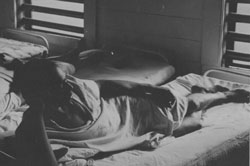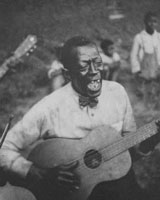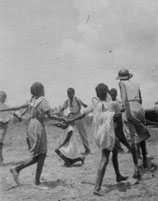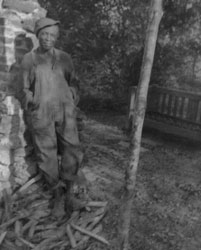|

Portrait
of an African American child, Eatonville, Fla.; A Methodist
church, Eatonville, Fla.; Portrait of a man holding a hat;
Portrait of Rev. Haynes, Eatonville, Fla. June, 1935. Lomax
collection of photographs depicting folk musicians, primarily
in the southern United States and the Bahamas. Prints and Photographs
Division, Library of Congress.
Teacher
Resources
NOTE:
This information is from the Teacher Resource section for Southern
Mosaic: The John and Ruby Lomax 1939 Southern States Recording
Trip
http://memory.loc.gov/ammem/ndlpedu/collections/lomax/history.html
Though
dating from the late 1930s, this collection reflects the
African-American experience in the South during the period
between
Reconstruction and 1941. The songs the Lomaxes collected come out
of a place that had changed very little since the Reconstruction
era, though it was on the brink of great transformation. The war
years that followed inaugurated a period of economic growth and
political change that culminated in the civil rights movement of
the 1950s and 1960s. Teachers should preview some of these materials,
particularly their language, to determine how much background about
cultural differences of the past students will need in order to
understand this collection appropriately.
Ruby Lomax's fieldnotes
document the racist atmosphere in the South, while the collection's
songs are African Americans' own personal expressions of what
it was like to live in the South. Do a full-text
search of white and negro for allusions to
segregation and prejudice such as the following. Or browse blues
songs and work songs from the Audio
Subject Index, for expressions of hopelessness, desperation,
violence, and perseverance in the face of a life of hard physical
labor, frequent relocation, injustice, and poverty. Search master and slave and
consider how racism and the African-American experience in
the South evolved and were reflected in song.
Henry Truvillion is foreman of a work gang for Wier Lumber Company, whose headquarters are at Wiergate, Texas . . . One evening later in the week we returned and set up our machine with batteries in the Truvillion living-room. We tried to
persuade Henry to go with us to our hotel in Newton, where we could hitch on to electricity, but he refused. He said frankly that
he was afraid, --afraid that such a visit to a white people's hotel might cause trouble for him after we were gone.
 Prisoner in camp hospital
Prisoner in camp hospital |
One particularly powerful documentation of racism and the African-American experience of the South is the collection's images, songs, lyrics, and notes, which reflect prison conditions for African-American inmates.
Do a keyword search and full-text search of convicts, inmates, prisons,
and chain gang to locate the materials that comprise this highlight
of the collection. |

Stavin' Chains playing guitar and singing . . .
Lafayette, La.. |
The variety of materials in this collection reflect the cultural life of African Americans in the South.
Browse Photo and Audio Subject
Indexes as well as the Fieldnotes for
materials documenting religion, work, rural lifestyle, children's play, and
music.
Locate African-American songs organized by geographical region
by referring to the Special Presentation, "The
1939 Recording Expedition". |
 children
playing singing games, Eatonville, Florida children
playing singing games, Eatonville, Florida
|
Mrs. Tartt had told us about the Tartt family of Negroes that lived in
the Boyd, Alabama community. She had heard the group sing together with
beautiful effect. Because of the rain she thought they would not be working
in the field
and drove the seventeen miles or more to their farm home to bring them in
to sing. She was told at their
house that "Sim an' them is huntin' fish". Mrs. Tartt walked through the mud
down to the river, calling as she went, to locate them the sooner. Finally she
heard a startled whisper, "Dat's Miss Ruby Callin'! Hear her? Reckin what she
want?" Then Mrs. Tartt, "Sim, Mandy, you heard me. Where are you?" They came
forth, bare-footed and thinly clad; for they really had been fish-hunting.
The high water, receding, had left live fish far up on the bank. These the
Negroes
were spearing and catching with bare hands.

Enoch Brown . . . Livingston, Alabama.
|
"There's ole Enoch", Doc Reed said as he sat on Mrs. Tartt's back "gallery" ready
to sing. We listened to the "hollerin"' as everybody calls it, though
that is too harsh a word for such a rounded-tones. He was crossing
the bridge over the Sacarnatchie that runs at the foot of Baldwin Hill.
He is artist enough to know that from just there his calls will sound
most effective. It is a sort of "hallo-ing", perhaps a form of yodeling,
though the words are those of field songs, with always a weird lonesomeness.
We could never quite get the effect into our microphone. Usually he
would call "oh-oh-oo-oo, I won't be here long", with variations on
that theme. Enoch is a strange person, the kind of person that we are
tempted to call "a strange creature", for he seems "other-worldly",
a wraith that appears suddenly out of darkness. . . . |
from the Lomax Fieldnotes
http://memory.loc.gov/cgi-bin/query/r?ammem/lomaxbib:@field(DOCID+@lit(fn0001))
|
